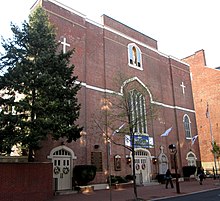St. Mary's Roman Catholic Church (Philadelphia)
| St. Mary's Roman Catholic Church | |
|---|---|
 |
|
| Location | 252 S. 4th Street Philadelphia, Pennsylvania, U.S. |
| Denomination | Catholic Church |
| History | |
| Founded | 1763 |
| Administration | |
| Diocese | Roman Catholic Archdiocese of Philadelphia |
St. Mary's Roman Catholic Church, also known as Old St. Mary's, is a historic church in Philadelphia, Pennsylvania. It is located in the Society Hill neighborhood at 248 S. Fourth Street, between Spruce and Walnut Streets.
Commonly referred to as "Old Saint Mary's", it opened in 1763 and was the second Catholic Church in Philadelphia 1763 after St. Joseph's. It is still an active parish of the Archdiocese of Philadelphia with Masses held on Saturdays at 4:30 p.m. and Sunday at 10 a.m. The current pastor is Paul A. DiGirolamo, J.C.D. The church is twinned with Holy Trinity Church at 6th and Spruce Streets, which serves as a worship site of St. Mary and which has Masses on holy days at 12 noon.
Old Saint Mary's was established as a more spacious worship site for Old Saint Joseph's church, a block away. Old Saint Joseph's had started as a chapel in a residence because public celebration of Catholic Mass was illegal at the time. In 1757, a larger church was built on the site of Old Saint Joseph's in Willings Alley; but six years later, Old St. Mary's was erected on a site which included room for a Catholic cemetery. St. Mary's and Old St. Joseph's remained a single parish until 1830. It was at St. Mary's, in 1782, that the first parish school connected to a Catholic church in America was opened. An interparochial school remains connected with the parish to this day.
Members of the Continental Congress and other public figures attended services on occasion at the church, since it was the city's most prominent Catholic church at the time. Among them were George Washington and John Adams, who observed that the visual and musical splendor of the church encompassed "everything that can lay hold of eye, ear, and imagination, everywhere which can charm and bewitch the simple and ignorant," adding, "I wonder how Luther ever broke the spell."
In 1810, after Philadelphia had been made a Diocese, St. Mary's was named the Cathedral, a role in which it continued until 1838, when St. John the Evangelist Church superseded it.
Under the first three bishops of the diocese, the trustees of St. Mary's were frequently at odds with the bishops; the disputes finally culminated in the temporary closure of the church in 1831 by Bishop Francis Patrick Kenrick, after which the disputes finally subsided.
...
Wikipedia
